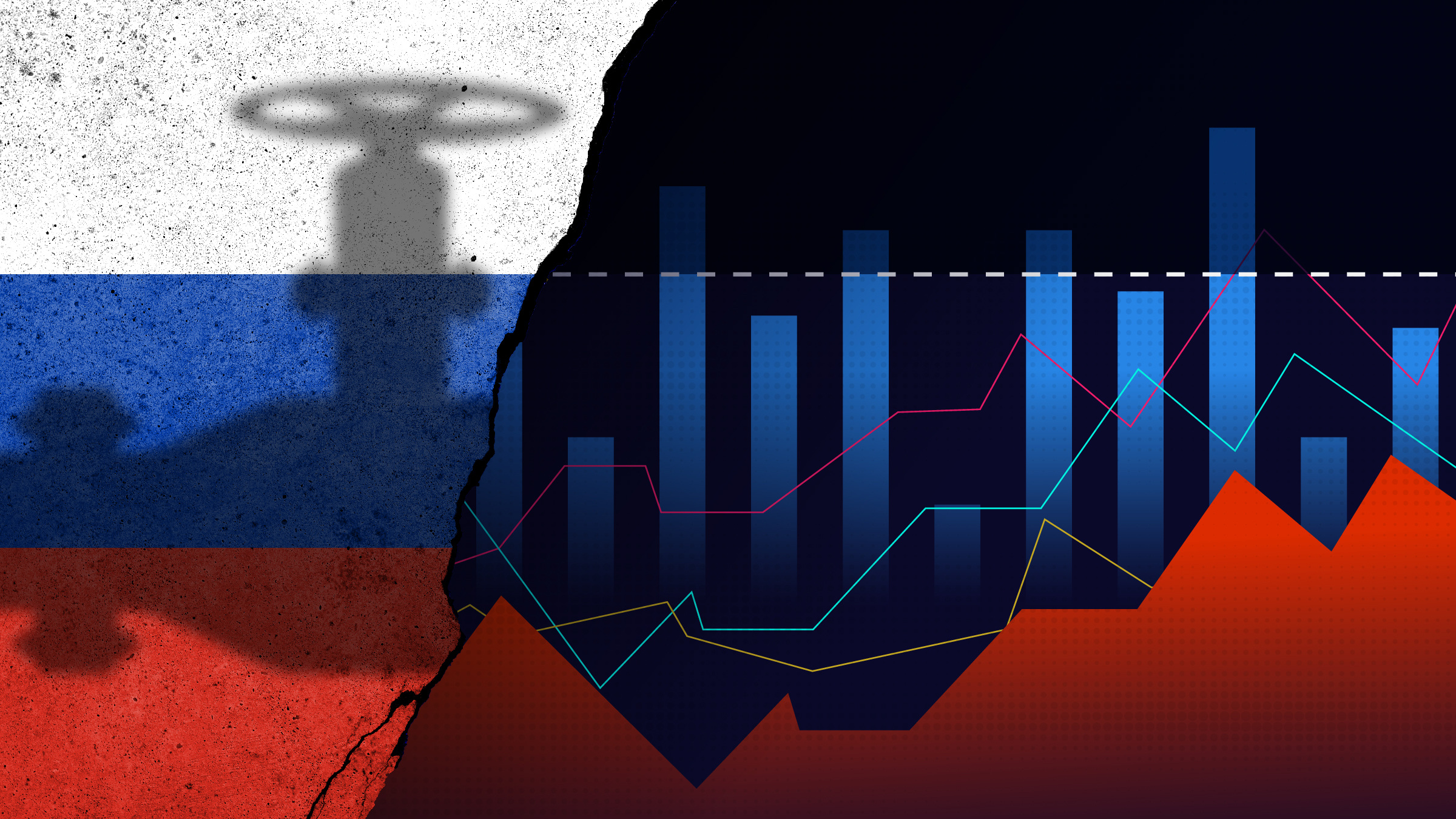Amid the array of restrictions on Russian industries and persons, it is tempting to view the new price cap on Russian oil as just one more attempt to tighten the vise.
“The price cap is mistakenly seen by many as another sanction, but it’s not really,” said Neil Mehrotra, an economist, assistant vice president, and policy advisor at the Minneapolis Fed. “It’s actually a pulling back of sanctions that would have been much more disruptive.”
When Russia invaded Ukraine, Mehrotra was the deputy assistant secretary for macroeconomic analysis at the U.S. Department of the Treasury. Despite Europe’s dependence on Russian energy, European governments laid the groundwork for an eventual ban on imported Russian oil. They also proposed to leverage European dominance in insurance, financing, and ocean shipping logistics to strike a deeper blow—by forbidding European firms to provide these essential services for Russian oil shipped anywhere in the world.
While starving Russia’s war effort was a top U.S. priority, this ban on shipping services posed its own risk to the American economy—even though the U.S. imports no Russian oil.1 “The Europeans were proposing a sanction that, if successful, could cause the price of oil to go to $150 or $200 a barrel,” Mehrotra said. “The U.S. doesn’t want Russian oil, Europeans don’t want Russian oil—that’s fine. But if Russian oil doesn’t get to the market somewhere, then there’s a global shortfall that would have significant ramifications for the price.” In recent years, Russia produced around 15 percent of the world’s oil.2
Mehrotra and his colleagues at Treasury drew up a novel solution: European firms could provide shipping services to Russian crude shipments only if Russia sold the oil below a specific price. “It’s a release valve so that some Russian oil can get out, while not giving Russia a windfall,” Mehrotra said. European and U.S. negotiators agreed at the 11th hour on a cap of $60 per barrel, implemented on Dec. 5, 2022, by the Group of Seven nations (including the U.S. and European Union) and Australia.3 A similar cap for refined petroleum products began Feb. 5, 2023.4
In his role at Treasury, Mehrotra advised Secretary Janet Yellen and Treasury officials on the effects of the proposal on the U.S. economy. He left Treasury in October 2022 to join the Minneapolis Fed.
We spoke on January 18, 2023.
The views cited in this article do not necessarily reflect those of the Federal Reserve Bank of Minneapolis or the Federal Reserve System.
As we are talking today, it has been about six weeks since the Russian oil price cap went into effect. How is it working?
Right now, it appears to be working in the sense that oil markets have not been significantly disrupted, and Russia appears to be collecting lower revenues than prior to the price cap (Figure 1). The Russian benchmark grade of oil is called “Urals.” Starting at the beginning of the of the war with Ukraine, Urals started to trade at a discount to Brent—which is the global benchmark price—because there were just fewer people who wanted to take the risk of transporting Russian oil.
Now that discount appears to have gone up further (Figure 2). Russia is being denied the ability to transact at over $60 a barrel—even in its transactions with countries that are not, per se, observing the price cap. We don’t think that China or India is trying to necessarily comply with the price cap. But they are [effectively complying] because they have leverage now, and they’re able to demand a relatively low market price for Russian oil.
I imagine it is difficult to tease apart the impact of the price cap from the effect of lower oil prices overall and the stigma of doing business with Russia.
Yes, it is—although there was this increase in the [Brent-Urals] spread after the price cap was imposed.
We have benefited a bit from global conditions [pushing down the price of oil]. The tightness in the energy market has receded somewhat because of slow growth in China and their exit from “zero-COVID,” and because we had large releases from the U.S. Strategic Petroleum Reserve.
So, I think there will still be challenges for the policy going forward. But it will also be the case that Russia’s ability to produce oil is going to diminish, because it was very reliant on Western firms to work on challenging projects in the Arctic and develop new oil resources. Having made themselves a pariah state, Russia is not going to be able to produce in the same quantities as they were in the past.
I’ve seen some reports that European companies are stocking up on Russian diesel before the price cap and European ban [on refined petroleum products] go into effect.5 We will see if there are more significant disruptions in those product markets, which tend to be a bit tighter. Russian diesel was an important export to Europe because most Europeans don’t use gasoline, they use diesel.
Have we seen any indication of a “shadow fleet” of oil tankers or other workarounds in terms of a black market for moving Russian oil?
There was a lot of criticism of the price cap from commodity traders—people who said, “Look, Treasury doesn’t understand how this market works, and the Russians will be able to easily circumvent whatever restrictions are put in place.” Our rejoinder was that it’s a relatively short trip from Russia to Europe, and most of the pipeline infrastructure in Russia for transporting oil to its ports is directed towards Europe. But it’s a much longer trip to redirect flows to the other large consumers—India, China, South America. It’s not clear that a fleet of ships exists that is large enough to do that. It’s also not clear that there is infrastructure outside of the U.S. and European Union in terms of maritime financing and insurance that would be large enough to facilitate that trade.
It appears that Western firms are still servicing the Russian oil trade, but in compliance with the price cap. That might be because right now the market price of oil is such that the price cap is not that severe. It could also be that the cap is “incentive-compatible”: If you’re a buyer of Russian oil (Figure 3), you can either pay a higher price and run afoul of sanctions, or you can pay a lower price and be compliant with sanctions.
Russia has said, “We’re not going to sell oil at a price lower than this”—they made that threat a lot—but they’re not in the position to carry that out.
The economics of setting an oil price cap
How did $60 per barrel wind up being the magic number that enough people could agree on?
This work was led by my colleague Catherine Wolfram, who was the deputy assistant secretary for climate and energy at Treasury. Russian oil has a very low marginal cost to produce. To the best of our knowledge, the marginal cost of producing oil in Russia is around $5 to $10 per barrel. When you take into account some of the more marginal wells, then maybe it’s closer to $20. The Russian government then collects various royalties and taxes that they impose on their producers, and we know that for budget-planning purposes they would usually target a break-even price of around $40 per barrel.
The price cap of $60 appealed to many because it was close to where Urals were trading, so it preserved a clear economic incentive for Russia to continue producing. It was also close to what Russia had been receiving pre-pandemic, so you can make the argument that we’re returning to a status quo level.
The hard thing is that $60 is still a decent price for oil, and Russia is collecting revenues from that. But because winter was coming, with uncertainties about the energy situation and economic concerns about recession, I think enough European countries wanted to be somewhat conservative and not start with too tight a cap.
Countries in Eastern Europe, closer to Russia, not surprisingly argued for a much lower cap. And as the war drags on—the overall goal here being to shorten the war and end it in Ukraine’s favor—do you anticipate a need to ratchet the cap down?
Countries that are more hawkish on Russia can legitimately ask: Why not $50? Why not $40? At those prices, Russia would still have an economic incentive to produce, but they would be making less than they’ve made in the past.
I can see it developing both ways. There are reasons to think that the cap is going to be more binding in the spring and summer of 2023, if Chinese demand comes back strongly and if the U.S. and global economies avoid a recession. In that case, the price of oil could go up significantly and $60 could become much more of a binding target.
But it’s hard to know how the war itself is going to play out. The Ukrainians seem to have the advantage right now, but if there’s an escalation there will certainly be pressure to further tighten the cap.
Right now the Europeans are thinking, “Look, Russia, you took your best shot at us, and we’re still standing.” As each day goes by, there’s more LNG [liquefied natural gas] infrastructure in Europe—the European economy is finding ways to reorient itself away from Russian energy. I think that might also be a force for tightening the cap.
There will be pressures on Russia on the supply side, too. With the loss of all these international partners, difficulty getting parts, and the need to try to export oil from eastern Russia or other places they’re not used to—that all would seem to drive up the marginal cost to produce Russian oil.
Yes, Russian production of oil is likely to be severely impacted. Another thing to note is that the sanctions regime imposed by the U.S. and imposed by Europe—apart from these energy sanctions—now appears to be having pretty severe impacts on the Russian economy. The idea that they could simply wall off their economy from the rest of the world—I don’t think that has proven out. There has been a huge out-migration of Russian professionals. There’s evidence that they’re running short on different types of intermediate goods that are needed for the war machine, but also for domestic aviation and things like that.
There has been this kind of sentiment out there that “Putin’s winning this, he’s too clever by half”—as oil prices were going up, and people who were paying close attention to the exchange rate were making the point that the Russian ruble had actually appreciated in value. But I don’t think that’s true. I think the evidence at the time suggested that while the sanctions would have some immediate impact, the impact would really compound over time. And that’s what we’re seeing now.
“An entirely novel effort”
As you and the other economists at Treasury and the State Department were working on the price cap, was there a template for designing this sort of policy?
No. The price cap is an entirely novel effort. Typically, U.S. sanctions have been just outright prohibitions on certain types of business with certain entities. The price cap is novel in that we are trying to facilitate trade, but only under certain terms.
In this sense, I think it became very challenging to try to explain what we were trying to do, and it made the policy more challenging in some ways to implement. I think this is definitely a new front in the tools of economic statecraft.
As a general rule, economists dislike the idea of price caps as economic policy because they tend to cause distortions and inadvertent consequences. As an economist, how did you reconcile that as you worked through this?
It was the only way to simultaneously achieve two objectives: Keep Russian energy on the market, but limit the profits that they were making off the trade.
In a sense, it’s a way to exert market power—in very much the same way that OPEC [Organization of the Petroleum Exporting Countries] and Russia have done relative to the rest of the world in setting production caps and implicitly targeting a global price of oil. This has never been a market that’s just laissez faire, a freely traded market. OPEC has often used these dynamics to try and manage the world price of oil.
That’s a great point: The market for oil is already uniquely noncompetitive.
Yes. I mean, the rough story of the decade prior to the pandemic was that the U.S. became a very large producer of oil from the shale revolution—it became roughly self-sufficient in oil. OPEC made production decisions both before and in the early part of the pandemic to make the losses large enough for U.S. shale companies that [OPEC members and Russia] would be able to preserve their market—the marginal cost to produce oil being higher here in the U.S. than in Saudi Arabia or in Russia (Figure 4).
Maybe one of the reasons why the price cap was seen as a threat was not specifically about Russia, but was [other OPEC countries wondering]: What if the countries that consume oil all get together and start doing something like this to us? That could have a substantial effect on OPEC.
Do you see this approach entering the regular economic policy or foreign policy toolkit?
I think that this is a pretty specific case. Russia’s just such a large producer of oil on global markets, and oil is obviously so important as an economic commodity. I don’t know what the template would be for dealing with another country. But I think that sanctions, in general, have become an important tool in terms of punishing countries that have violated international norms or engaged in bad behavior. And I can see that continuing.
As you continue to follow the impact on oil markets and on Russia, how does that provide valuable input as you think about the monetary policy decisions of the Fed and our understanding of the U.S. economy?
Energy has been an important driver of price dynamics over the last year. It has obviously been very salient for U.S. consumers and important for shaping at least some of their short-term inflation expectations. The Fed typically tries to “look through” volatility in oil and other commodity markets. But those are important drivers of realized inflation and the dynamics of how firms think about inflation. It has been an important driver of inflation in Europe.
I’m personally interested in looking more at this interplay between energy and broader inflation. It is not a coincidence that we’ve had periods of high inflation, like in the ’70s and today, around discrete oil price disruptions. We need to think more about how those dynamics are woven together.
In terms of economic policy, this was a unique thing to be able to work on—obviously something that’s quite far from what the Fed normally works on. It really speaks to the range of responsibilities that Treasury and Treasury economists deal with.
This interview was edited for length and clarity.
Endnotes
1 The Biden administration banned imports of oil and other energy products from Russia in March 2022. Although the U.S. is the world’s largest oil producer, it remains a significant importer of oil due to refinery characteristics and restrictions on shipping oil between U.S. ports. In 2021, U.S. crude oil imports measured 54 percent of its domestic production. Russia accounted for 8 percent of U.S. oil and petroleum product imports in 2021, versus 51 percent from Canada.
2 Russian crude production peaked in 2019 at 15.8 percent of worldwide production, According to the Joint Organizations Data Initiative (via Knoema).
3 The G-7 countries are Canada, France, Germany, Italy, Japan, the United Kingdom, and the United States. The European Union itself is also considered a member (though not numbered among the seven).
4 In conjunction with the two price cap actions, the EU also banned its own imports of Russian oil and, subsequently, refined petroleum products.
5 This interview took place prior to the start of the petroleum products price cap on Feb. 5, 2023.
Jeff Horwich is the senior economics writer for the Minneapolis Fed. He has been an economic journalist with public radio, commissioned examiner for the Consumer Financial Protection Bureau, and director of policy and communications for the Minneapolis Public Housing Authority. He received his master’s degree in applied economics from the University of Minnesota.







